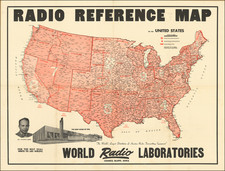The Geographically Correct Map of the Chicago & North-Western Railway and Its Principal Connections is an 1883 railroad map that traces the network of the North-Western railway, one of the leading railways of the West and Northwest. Printed by Rand, McNally & Co. in Chicago, this railroad map not only illustrates the transportation web of its era but also provides a snapshot into the socio-economic milieu of late 19th-century America.
The Chicago & North-Western Railway, known popularly as "The North-Western," held a prominent position in the American West and Northwest. Operating nearly 4,000 miles of road, it formed major through lines connecting various important urban centers and regions, including Denver, California, Southern Dakota, Des Moines, Freeport, Dubuque, St. Paul, Minneapolis, La Crosse, Winona, Central Dakota, Pierre, Deadwood, Milwaukee, Marquette, Green Bay, and Lake Superior.
This map captures the extensive reach of the North-Western, but it also brings to light the importance of these railway lines in linking disparate parts of the country, facilitating trade, migration, and cultural exchange. By showcasing the critical connections between these urban centers, the map serves as a reminder of the railway's central role in structuring the geographical and socio-economic landscape of the time.
What distinguishes this map is its dual-sided print. The recto exhibits a color-printed map of the northern United States, while the verso features a plethora of illustrations, tables, and a dedicated map for tourist routes to Yosemite. This juxtaposition of functional railway lines with tourist routes reflects the increasing leisure travel of the period, and the rising popularity of destinations like Yosemite.
Consequently, the Geographically Correct Map of the Chicago & North-Western Railway and Its Principal Connections serves not only as a navigational tool but also as a comprehensive depiction of the interconnectedness of 19th-century America, embodying both the daily travel routines and the emerging tourism trends of the era.
Rarity
The map is very rare. OCLC locates one example of the editions in 1879, 1880 and 1884.
Rand McNally & Co. is a large American map and navigation company best known for its annual atlases. The company got its start in 1856, when William Rand opened a print shop in Chicago. He was joined in 1858 by a new employee, Andrew McNally. Together, the men established their namesake company in 1868. Originally, the company was intended to print the tickets and timetables for the trains running to and through Chicago; their first railway guide was published in 1869.
By 1870, they had shifted from just printing to publishing directories, travel guides, and newspapers. Their first map appeared in 1872 in a railway guide. The map was produced using a new wax engraving method, a cheaper process that gave the company an edge.
By 1880 Rand McNally had entered the education market with globes, wall maps, and geography texts for students. In 1923, Rand McNally published the first Goode’s World Atlas, named after its editor, Dr. J. Paul Goode. For generations afterward, this would be the standard classroom atlas.
In 1899, William Rand left the company, but McNally and his family remained, controlling the company for over a century. In 1904, they published their first road map intended for automobiles and by 1907 were publishing Photo-Auto Guides, which combined photography and mapping to help drivers. In 1924, they produced the Auto Chum, a precursor to their famous road atlases. Rand McNally would remain the leader in road maps and atlases throughout the twentieth century.
In 1937, Rand McNally opened its first store in New York City. Ever on the frontier of technology, Rand McNally pioneered the scribing process for printing tickets in 1958 and printed their first full-color road atlas in 1960. Arthur Robinson developed his now-famous projection of Rand McNally in 1969. By the 1980s, the company was exploring digital reproduction and digital databases of maps for truckers. In the 1990s, they lead the charge to develop trip-planning software and websites. Today, most of its products are available online or in a digital format, including maps for tablets and phones.











![[ Atlas of The United States ] Karte von Amerika](https://storage.googleapis.com/raremaps/img/small/84353mp2.jpg)
![Colton's United States Shewing Military Stations, Forts &c. . . . 1861 [Shows Colorada!]](https://storage.googleapis.com/raremaps/img/small/95088.jpg)

![[ Southern Railroads ] Railroad Map of the Southern States Shewing the Southern & Southwestern Railway Connections With Philadelphia. 1862 . . . Prepared by Thomas Kimber Jr., Chairman of the Committee on Inland Transportation of the Board of Trade of Philadelphia](https://storage.googleapis.com/raremaps/img/small/103211.jpg)
![Gen. Washington [On The Battlefield At Trenton] Engraved by W. Warner from the original picture by Col John Trumbull](https://storage.googleapis.com/raremaps/img/small/103233.jpg)
![United States Atlas [rolled]](https://storage.googleapis.com/raremaps/img/small/91367.jpg)